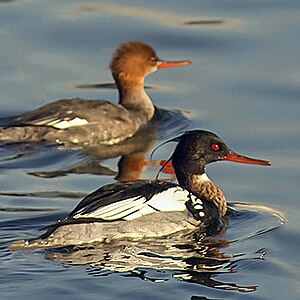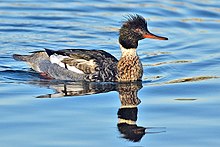Middle saw
| Middle saw | ||||||||||||
|---|---|---|---|---|---|---|---|---|---|---|---|---|

Midsummer ( Mergus serrator ) |
||||||||||||
| Systematics | ||||||||||||
|
||||||||||||
| Scientific name | ||||||||||||
| Mergus serrator | ||||||||||||
| Linnaeus , 1758 |
The means sawyer ( Mergus serrator ) is an approximately mallard large bird art from the family of the Anatidae (Anatidae). The species belongs to the so-called sea ducks . In contrast to the goosander , the medium- sized sawmill is a coastal bird in Central Europe and is rarely seen as an errant in the interior . The wadden coast of the North Sea is one of the most important winter quarters for this species. Up to 10,000 individuals of this species gather here in January.
The IUCN classifies the Mitteläger as not at risk ( least concern ), as the range of this species is very large and the population numbers seem to be stable.
Appearance and voice
The middle saw reaches a body length of 50 to 60 centimeters. The wingspan is 70 to 85 centimeters. Middle saws weigh between 950 and 1,200 grams.
The male has a black-green head, neck and nape in a magnificent dress . The eye-catching spring bonnet is divided into two parts and looks shaggy. The neck ring is wide and white. The chest is rust-brown - it is often referred to as a chest band. The back is black apart from a white stripe. In the plain dress the drake resembles the female.
The female is ash gray on top, the neck and head are reddish brown. The females of the middle sawdust differ from the very similarly colored females of the goose saw in the lack of the white spot on the chin that the female goose saws have on the head. Like the male, the female also wears a protruding feather bonnet , the ends of which look a bit torn. The long beak with lamellas makes it easier to hold on to the prey and is reminiscent of a saw.
During courtship the male calls out a deep, hoarse gwäng , a nasal krikiräh or a Krikirie-krikriee sequence. The female's voice is a rag-rag… .
distribution
The middle saunter occurs mainly in Northern Europe, North America, Asia and the British Isles. The main wintering area is in the North and Baltic Seas. Only in very cold winters does it evade into the Mediterranean. The breeding area extends over the entire northern hemisphere.
Habitat and way of life
The bird lives on coasts, islands, lakes and wooded river banks. The middle saunter is diurnal and sociable. The male has a striking courtship game. The female is requested to mate by lying flat on the water.
nutrition
In addition to fish (no larger than 10 cm), it feeds on crustaceans and worms. The prey is often hunted by several hunters and caught by diving after a driven hunt.
Reproduction
Middle saws lead a seasonal marriage. The female chooses a nesting place in burrows, on the ground between dense vegetation, between stones and mostly built close to the water. In contrast to the goosander , nesting holes in trees or nesting boxes are rarely used. The clutch consists of 5 to 12 brownish eggs. The female incubates for about 31 days and leads the young birds. The nestling period lasts 60 to 65 days. The animals are sexually mature when they are two years old.
Stock and stock forecast
The total population worldwide is 0.5 to 0.6 million individuals. In Europe there are 70,000 to 120,000 breeding pairs. The majority of it occurs in Fennoscandinavia and the European part of Russia. In Central Europe, the middle sawmill is mainly found on the coast. Central European inland birds are almost only found from Poland to the east. There are around 340 to 410 breeding pairs in Germany.
In parts of Central Europe, the middleman was a regular breeding bird. Until the beginning of the 20th century, the inland lakes in north-eastern Germany were also populated by middle saws. These were only given up after the Second World War. In the west of Poland, too, there was a significant decline in stocks and land. This trend has reversed again in the last few decades. In Germany, the population increased from less than 400 breeding pairs to 800 breeding pairs between 1970 and the mid-1980s. In the meantime there are again small isolated breeding populations in various federal states. A research team that, on behalf of the British environmental authority and the RSPB, examined the future development of the distribution of European breeding birds on the basis of climate models, however, assumes that there will be a widespread shift in the breeding area of the Middle Saw by the end of the 21st century as a result of global warming will come north. Based on these prognoses, the species will then be absent as a breeding bird in Central Europe and in parts of Fenno Scandinavia.
literature
- Hans-Günther Bauer, Einhard Bezzel and Wolfgang Fiedler (eds.): The compendium of birds in Central Europe: Everything about biology, endangerment and protection. Volume 1: Nonpasseriformes - non-sparrow birds. Aula-Verlag Wiebelsheim, Wiesbaden 2005, ISBN 3-89104-647-2 .
- Hartmut Kolbe: The world's ducks. Ulmer Verlag 1999, ISBN 3-8001-7442-1
- Richard Sale: A Complete Guide to Arctic Wildlife , published by Christopher Helm, London 2006, ISBN 0-7136-7039-8
Web links
- Picture of some saws 1
- Picture of some saws 2
- Picture of some saws 3
- Nature lexicon - text with photos
- Mergus serrator in the endangered Red List species the IUCN 2008. Posted by: BirdLife International, 2008. Accessed January 31 of 2009.
- Videos, photos, and sound recordings for Mergus serrator in the Internet Bird Collection
- BirdLife factsheet about the middle saw
- Springs of the middle saw
Individual evidence
- ↑ BirdLife Factsheet on Mitteläger , accessed December 14, 2010
- ↑ Sale, p. 132
- ↑ Hans-Heiner Bergmann; Hans-Wolfgang Helb; Sabine Baumann; The voices of the birds of Europe - 474 bird portraits with 914 calls and chants on 2,200 sonograms , Aula-Verlag, Wiesbaden 2008, ISBN 978-3-89104-710-1 ; P. 75. This source was used for the onomatopoeic description of the voices.
- ↑ BirdLife International (Ed.): European birds of conservation concern: Populations, trends and national responsibilities . Cambridge 2017, ISBN 978-1-912086-00-9 , pp. 167 (English, birdlife.org [PDF; accessed January 27, 2020]).
- ↑ Bauer et al., P. 145
- ^ Brian Huntley, Rhys E. Green, Yvonne C. Collingham, Stephen G. Willis: A Climatic Atlas of European Breeding Birds , Durham University, The RSPB and Lynx Editions, Barcelona 2007, ISBN 978-84-96553-14-9 , P. 77



